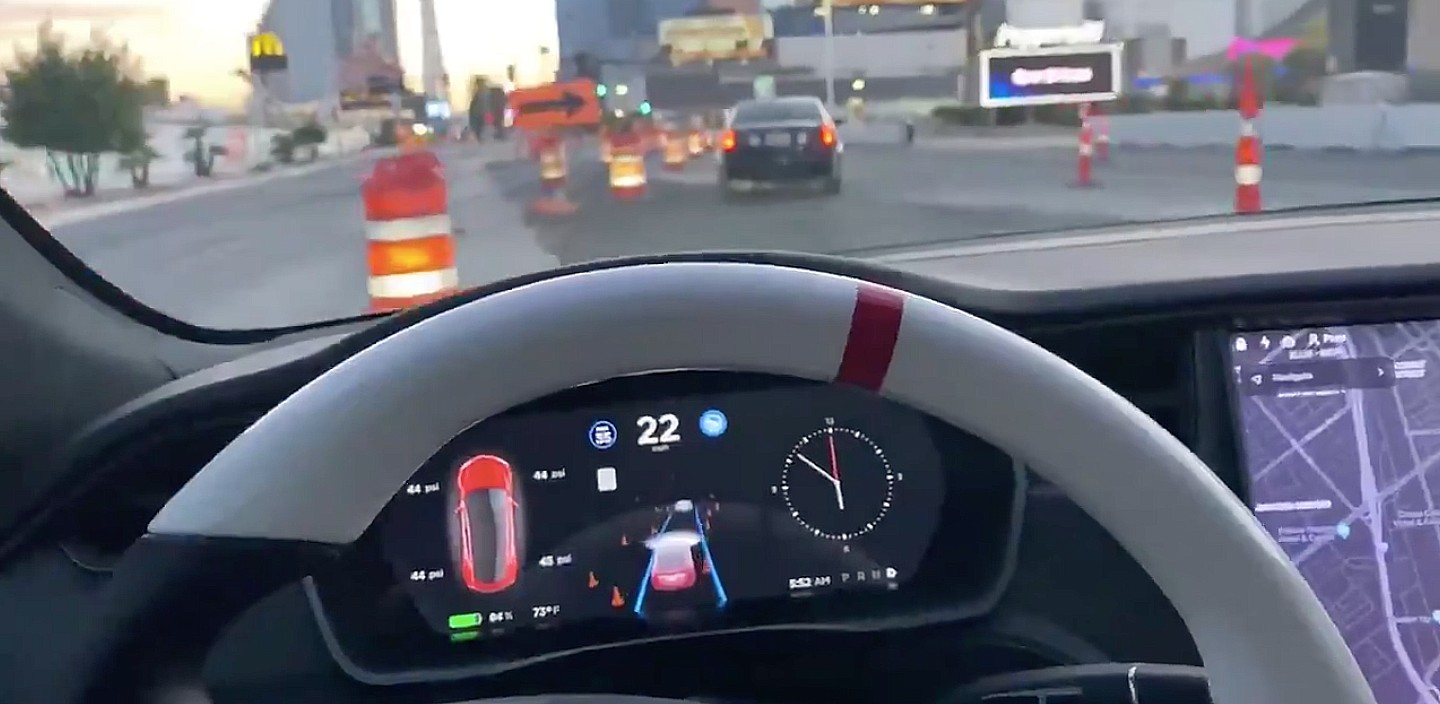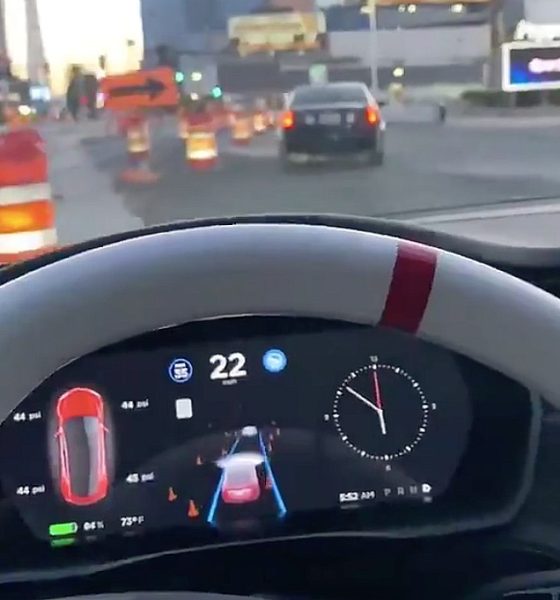

News
Tesla Autopilot twists and turns through complex Sin City construction zone on its own
The owner of a Tesla Model S released footage of his electric sedan seamlessly navigating on Autopilot through the sharp and narrow twists and turns of a construction zone.
Model S owner Fred Hassen was traveling on South Las Vegas Boulevard in the “Sin City” while using the vehicle’s Navigate on Autopilot feature as part of the Full-Self Driving suite. The Model S car managed to recognize the confusing lane shifts and road changes and navigate through the cones and safety barrels that were set up by local construction crews. Hassen seemed pleased by his car’s flawless navigation through the make-shift lanes, as can be heard in his video.
The appearance of traffic cones and traffic light indicators on the Model S’ instrument cluster suggests that the vehicle is equipped with Tesla’s latest Hardware 3 and capable of responding to red traffic lights and stop signs, including automatically stopping.
Autopilot progress in clearly marked construction zones is mighty impressive https://t.co/tb1tsuRQaD
— TREV PAGE (@Model3Owners) April 23, 2020
Navigate on Autopilot is one of the most sophisticated driver-assistance features in the automotive industry today. The suite is capable of performing lane changes, navigating through on and off-ramps, and helping drivers make their way through confusing construction zones. The development of Tesla’s software for its self-driving features helps the company work toward a “feature complete” Full Self-Driving suite, which aims to revolutionize the act of driving for every owner in the world.
Tesla’s Artificial Intelligence and Autopilot systems were broken down by Andrej Karpathy, Director of the company’s AI team. Karpathy explained that Tesla’s use of vehicle cameras and artificial intelligence trains its neural network to help cars respond to road conditions safely and accurately. Tesla’s fleet of 1,000,000 vehicles uses “raw images to perform semantic segmentation, object detection, and monocular depth estimation,” according to its website. These images are then used as data to improve the safety of Autopilot.
The data compiled by the fleet of Tesla vehicles is critical to Tesla’s teams who determine improvements that need to be made within the company’s self-driving software. Tesla vehicles likely travel through construction zones every day, but the performance of the cars continues to improve through its continuously-learning Neural Network.
In the past, a Tesla hacker known as “green” has showed Tesla Autopilot’s thought process when navigating through construction zones.
and finally a bit of construction zone (this is the only one of the set where AP is actually on), nothing groundbreaking since it was widely reported already long ago, but still interesting to see it "from the inside": pic.twitter.com/TmGkqhGPQz
— green (@greentheonly) November 7, 2019
The technology seems to recognize cones as the guidance point for the lane, forgetting about painted “on-road” lines when construction zones are concerned. The car understands that the standard path of travel is obsolete because of construction. Autopilot instead uses the cones lined up on both sides of the lane as the new guidance markers for travel. This video is from a previous version of firmware, so the program has improved since then as more data has entered the Neural Network.
Tesla initial plans were to release the “feature complete” FSD suite by the end of 2019, but the program was not ready for a full release. After the company release Stop Sign and Traffic Light recognition in mid-April, all that is left for Tesla to unveil is city driving. As the cars seem to be navigating through tricky construction zones with relative ease, city street driving could roll out soon.

Elon Musk
Elon Musk’s X will start using a Tesla-like software update strategy
The initiative seems designed to accelerate updates to the social media platform, while maintaining maximum transparency.

Elon Musk’s social media platform X will adopt a Tesla-esque approach to software updates for its algorithm.
The initiative seems designed to accelerate updates to the social media platform, while maintaining maximum transparency.
X’s updates to its updates
As per Musk in a post on X, the social media company will be making a new algorithm to determine what organic and advertising posts are recommended to users. These updates would then be repeated every four weeks.
“We will make the new 𝕏 algorithm, including all code used to determine what organic and advertising posts are recommended to users, open source in 7 days. This will be repeated every 4 weeks, with comprehensive developer notes, to help you understand what changed,” Musk wrote in his post.
The initiative somewhat mirrors Tesla’s over-the-air update model, where vehicle software is regularly refined and pushed to users with detailed release notes. This should allow users to better understand the details of X’s every update and foster a healthy feedback loop for the social media platform.
xAI and X
X, formerly Twitter, has been acquired by Elon Musk’s artificial intelligence startup, xAI last year. Since then, xAI has seen a rapid rise in valuation. Following the company’s the company’s upsized $20 billion Series E funding round, estimates now suggest that xAI is worth tens about $230 to $235 billion. That’s several times larger than Tesla when Elon Musk received his controversial 2018 CEO Performance Award.
As per xAI, the Series E funding round attracted a diverse group of investors, including Valor Equity Partners, Stepstone Group, Fidelity Management & Research Company, Qatar Investment Authority, MGX, and Baron Capital Group, among others. Strategic partners NVIDIA and Cisco Investments also continued support for building the world’s largest GPU clusters.
News
Tesla FSD Supervised wins MotorTrend’s Best Driver Assistance Award
The decision marks a notable reversal for the publication from prior years, with judges citing major real-world improvements that pushed Tesla’s latest FSD software ahead of every competing ADAS system.

Tesla’s Full Self-Driving (Supervised) system has been named the best driver-assistance technology on the market, earning top honors at the 2026 MotorTrend Best Tech Awards.
The decision marks a notable reversal for the publication from prior years, with judges citing major real-world improvements that pushed Tesla’s latest FSD software ahead of every competing ADAS system. And it wasn’t even close.
MotorTrend reverses course
MotorTrend awarded Tesla FSD (Supervised) its 2026 Best Tech Driver Assistance title after extensive testing of the latest v14 software. The publication acknowledged that it had previously criticized earlier versions of FSD for erratic behavior and near-miss incidents, ultimately favoring rivals such as GM’s Super Cruise in earlier evaluations.
According to MotorTrend, the newest iteration of FSD resolved many of those shortcomings. Testers said v14 showed far smoother behavior in complex urban scenarios, including unprotected left turns, traffic circles, emergency vehicles, and dense city streets. While the system still requires constant driver supervision, judges concluded that no other advanced driver-assistance system currently matches its breadth of capability.
Unlike rival systems that rely on combinations of cameras, radar, lidar, and mapped highways, Tesla’s FSD operates using a camera-only approach and is capable of driving on city streets, rural roads, and freeways. MotorTrend stated that pure utility, the ability to handle nearly all road types, ultimately separated FSD from competitors like Ford BlueCruise, GM Super Cruise, and BMW’s Highway Assistant.
High cost and high capability
MotorTrend also addressed FSD’s pricing, which remains significantly higher than rival systems. Tesla currently charges $8,000 for a one-time purchase or $99 per month for a subscription, compared with far lower upfront and subscription costs from other automakers. The publication noted that the premium is justified given FSD’s unmatched scope and continuous software evolution.
Safety remained a central focus of the evaluation. While testers reported collision-free operation over thousands of miles, they noted ongoing concerns around FSD’s configurable driving modes, including options that allow aggressive driving and speeds beyond posted limits. MotorTrend emphasized that, like all Level 2 systems, FSD still depends on a fully attentive human driver at all times.
Despite those caveats, the publication concluded that Tesla’s rapid software progress fundamentally reshaped the competitive landscape. For drivers seeking the most capable hands-on driver-assistance system available today, MotorTrend concluded Tesla FSD (Supervised) now stands alone at the top.
News
Elon Musk’s Grokipedia surges to 5.6M articles, almost 79% of English Wikipedia
The explosive growth marks a major milestone for the AI-powered online encyclopedia, which was launched by Elon Musk’s xAI just months ago.

Elon Musk’s Grokipedia has grown to an impressive 5,615,201 articles as of today, closing in on 79% of the English Wikipedia’s current total of 7,119,376 articles.
The explosive growth marks a major milestone for the AI-powered online encyclopedia, which was launched by Elon Musk’s xAI just months ago. Needless to say, it would only be a matter of time before Grokipedia exceeds English Wikipedia in sheer volume.
Grokipedia’s rapid growth
xAI’s vision for Grokipedia emphasizes neutrality, while Grok’s reasoning capabilities allow for fast drafting and fact-checking. When Elon Musk announced the initiative in late September 2025, he noted that Grokipedia would be an improvement to Wikipedia because it would be designed to avoid bias.
At the time, Musk noted that Grokipedia “is a necessary step towards the xAI goal of understanding the Universe.”
Grokipedia was launched in late October, and while xAI was careful to list it only as Version 0.1 at the time, the online encyclopedia immediately earned praise. Wikipedia co-founder Larry Sanger highlighted the project’s innovative approach, noting how it leverages AI to fill knowledge gaps and enable rapid updates. Netizens also observed how Grokipedia tends to present articles in a more objective manner compared to Wikipedia, which is edited by humans.
Elon Musk’s ambitious plans
With 5,615,201 total articles, Grokipedia has now grown to almost 79% of English Wikipedia’s article base. This is incredibly quick, though Grokipedia remains text-only for now. xAI, for its part, has now updated the online encyclopedia’s iteration to v0.2.
Elon Musk has shared bold ideas for Grokipedia, including sending a record of the entire knowledge base to space as part of xAI’s mission to preserve and expand human understanding. At some point, Musk stated that Grokipedia will be renamed to Encyclopedia Galactica, and it will be sent to the cosmos.
“When Grokipedia is good enough (long way to go), we will change the name to Encyclopedia Galactica. It will be an open source distillation of all knowledge, including audio, images and video. Join xAI to help build the sci-fi version of the Library of Alexandria!” Musk wrote, adding in a later post that “Copies will be etched in stone and sent to the Moon, Mars and beyond. This time, it will not be lost.”








